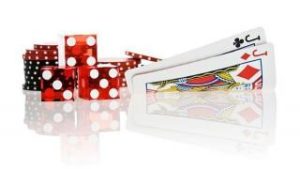Poker Odds Explained – Pot Odds
 Poker odds tell you how often an event fails to occur. In other words, how many times you’re going to lose versus how many times you’re going to win. A simple to way to use poker odds to your advantage is to compare them to pot odds and determine whether you’ll be able to play profitably or not.
Poker odds tell you how often an event fails to occur. In other words, how many times you’re going to lose versus how many times you’re going to win. A simple to way to use poker odds to your advantage is to compare them to pot odds and determine whether you’ll be able to play profitably or not.
What Are Pot Odds?
Pot odds are used to determine whether your decision is profitable or not. In fact, most of the poker theory revolves around the basic concept of pot odds. You always have to consider risk and reward and, no matter what, you always make decisions based on poker odds to some degree.
Betonline Poker - #1 in the U.S
- Accepts U.S. customers with large player pool
- 10+ years with a strong reputation
- $2,500 deposit bonus
Calculating Pot Odds
Calculating pot odds is about learning whether it’s beneficial to risk $X in order to win the pot when your probability of winning is Y%. The amount in the pot to the amount you have to call is your pot odds. In other words, the ratio of pot to involuntary bet.
Here’s the calculation: (Pot + Bet) / Bet = Pot Odds
Example:
With $2000 in the pot, your opponent bets $1500. What are your pot odds? Here’s the calculation: ($2000 + $1500) : $1500 = 2.3 : 1
So your poker pot odds are 2.3 to 1. The easiest way to understand what this actually means is to translate the ratio into a percentage. Here are two ways of doing it:
- The pot odds ratio is 2.3 : 1, so you calculate the sum of those numbers (in this case, 2.3 + 1 = 3.3) and then calculate 100% : 3.3 = 30,3%.
- Another way of translating the odds ratio into a percentage is to calculate the sum of the numbers in the ratio (2.3 + 1 = 3.3) and then calculate (1 : 3.3) * 100% = 30.3%.
The percentage tells us the minimum amount of time we need to win the pot in order to turn a profit. So in the example above, you need to win at least 30.3% of those situations in order to justify your call. If you win less than 30.3%, calling would be unprofitable.
And that is the basic idea of any poker hand: to figure out whether you win the hand often enough to call, bet or raise profitably.
Example #2: You’re on the button. There’s $500 in the pot. Your opponent bets $400. You suspect your hand beats the opponent in 40% of these situations, so how to figure out whether you can call profitably?
- ($500+$400):$400 = 2.25:1
- 100%:(2.25+1) = 30.8%
- You would make a profitable call in this situation.
To become a winning player, the goal should be to learn how to calculate poker odds during actual play, not just afterward (although calculating them at any point is a good start). This is surprisingly easy, as most of the time you’re going to be in one of these situations, so memorize them and you’re well on your way:
| Odds | Percentage | Situation |
| 2 : 1 | 33.3% | When someone bets full pot. In other words, when there’s $100 in the pot and someone bets $100, you get 2 : 1 pot odds. |
| 2.3 : 1 | 30.3% | When someone bets 3/4 of the pot. In other words, when there’s $100 in the pot and someone bets $75, you get 2.3 : 1 pot odds. |
| 2.5 : 1 | 28.6% | When someone bets 2/3 of the pot. In other words, when there’s $100 in the pot and someone bets $66.6, you get 2.5 : 1 pot odds. |
| 3 : 1 | 25% | When someone bets half of the pot. In other words, when there’s $100 in the pot and someone bets $50, you get 3 : 1 pot odds. |
| 5 : 1 | 16.6% | When someone bets 1/4 of the pot. In other words, when there’s $100 in the pot and someone bets $25, you get 5 : 1 pot odds.
Usually used to not to go to the showdown when a player senses that his opponent is either going to check or fold.Also used when your opponent refuses to believe that you will call a bigger bet but wants to get some money out of you. Remember that you only have to win over 16.6% of these situations. |
Implied Pot Odds
Implied odds are used estimate the money that can be won (or lost) during the later stages of a hand. They consider what happens on future streets and give you a more realistic idea of your odds of winning. Calculating implied poker odds requires more skill and experience because you need a good idea of how the opponent is going to react in the future. Should you predict an opponent’s actions inaccurately, you’ve also made inaccurate calculations, which in turn affects your bottom-line negatively.
Simply put, you calculate whether it’s a good decision to commit money into the pot based on how often you’re going to fold in the future (and lose no additional bets) and how often you’re going to hit your draw and make more money in the future (and win additional bets).
So the idea is the same as with pot odds except you also consider future bets. It’s easier to calculate implied poker odds in fixed limit Hold’em since you know how much your opponents can bet. In no-limit, need to correctly predict an opponent’s bet sizes. In pot-limit, you know the maximum your opponent can bet.
Example: You’re on the turn. You check and your opponent bets. There’s $30 in the pot (including your opponent’s bet) and you have $10 to call.
You get 3:1 pot odds.
If you call now, you expect the opponent to call your bet on the river each time you hit your draw, but only when the bet is max. 75% of the pot. You, on the other hand, are going to check/fold each time you fail to hit your draw.
You’re on a flush draw, and therefore you have 9 outs out of 46 remaining cards, meaning 5.1:1 odds of hitting your draw.
By simply looking at pot odds, you would either fold or raise (hoping to bluff your opponent out of the pot). But what about implied odds? As mentioned, the opponent calls your bet 100% of the time, so how much is the minimum you have to be able to bet (and get called) in order to make the play profitable?
Obviously you haven’t got very good pot odds at all. What about implied pot odds? The actual challenge when determining implied pot odds is to calculate the amount of money that you think you can likely win, and the amount of money that you absolutely have to win in order to make profit.
You have 3:1 odds and you need better than 5.1:1 odds, so you need to improve your odds by at least 2.1:1. In this case, 2.1 multiplied by the amount to call ($10) is $21. By getting your opponent to call your bet when it’s more than $21 every time you hit your draw, you would play profitably.
And how do you make sure of that the math above works? Here’s how:
0.836*10 = 0.164(30+x)
8.36 = 4.92+0.164x
-0.164x = 4.92-8.36
-0.164x = -3.44
0.164x = 3.44
x = 3.44/0.164 = 21You multiply the amount you have to call by the times you fail to hit your draw and also multiply the amount in the pot and the money you need to win to justify a call (“x”) by the times you do hit your draw. Then you simply figure out what “x” is.
75% of the pot, which the opponent calls every time, is $30. You would make a profitable play here, since the opponent had to be willing to call $21 or more.
If the example above was hard to understand, please re-read it until you get it. The conditions were simplified for the sake of the example (the opponent always calls when bet is max. 75% of the pot, for instance–this is rarely the case).
Value of nut draws:
Nut draws are more valuable mainly because of two reasons:
- A player might end up in situations where he and his opponent both hit their draws, and if you’re the one with the nut draw, you’ll be able to make a lot of money out of that hand.
- It can go the other way around, and you’ll be in huge trouble if both of you hit your draws, but your opponent’s got the nut draw.
Overestimating implied odds:
Many players often learn about implied poker odds and start justifying every other situation with “plus, I’ve got implied odds” without doing the math. You need to go through the calculations 100s of times before you can make educated estimates on your implied odds, and even still, you should keep doing them until the day you stop playing poker for real money.
Determining correct implied odds relies on how well you can analyze opponents. Unless you have a good idea of what the opponent is going to do, use basic pot odds. Implied odds work only if you can make an educated prediction on how your opponent is going to react.
Can you sell it?
The success of your implied odds decisions also depends on your skills to extract money from your opponents. Players have different success rates in different situations (because of their image, for example). While one player might be able to get his opponent to commit the needed $21+, another player might not. You truly need to understand your capabilities.
Odds, Math, and Poker
Poker isn’t just about math but it’s all about odds. What are the odds of your opponent folding, calling or raising? What are the odds of you hitting your outs? What are the odds of your opponent hitting his outs? On some level, you’re always thinking about odds.

